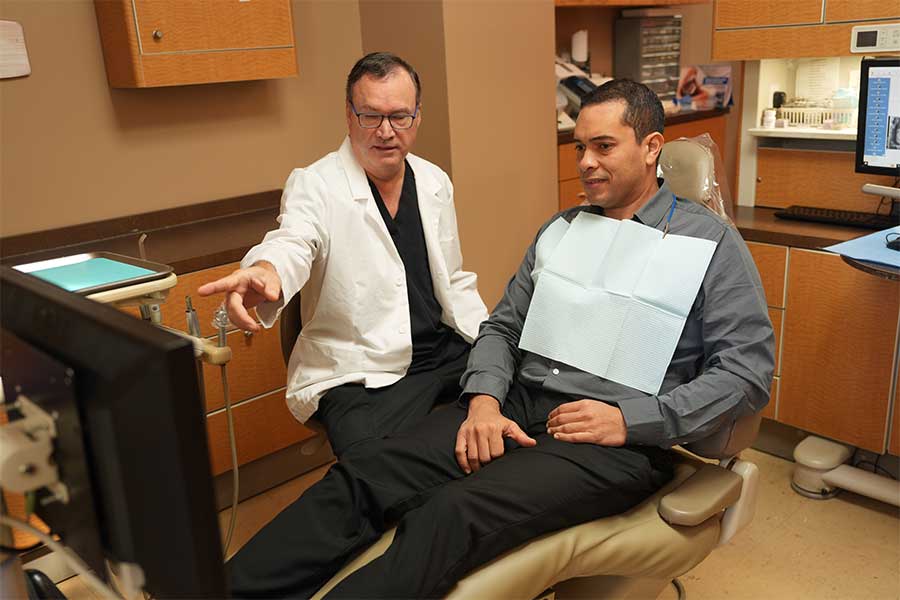- New Patient Special
- Serving the Atlanta Metro and Midtown Area Since 1982
- (404) 872-7755
Dental bonding offers a quick and effective way to make small, cosmetic changes to the front of a tooth. For those seeking a gentle “facelift” as an alternative to lengthy cosmetic procedures, our dentists recommend bonding to repair cracks, chips, and flaws, as well as to whiten teeth.
In this process, we apply a tooth-colored resin material to the surface of the tooth and harden it with a special light, which securely “bonds” the material to the tooth. This technique ultimately restores or improves a person’s smile. While dental bonding can be a more affordable alternative to veneers, porcelain veneers may provide a longer-lasting result.
Dental bonding can effectively address a variety of dental issues. For instance, it can be used to:

The first step in any cosmetic procedure is to conduct a full examination of your teeth and mouth, followed by a review of the different options available to create a beautiful smile. Many cosmetic procedures can be done without cutting and with minimal preparation. Moreover, our procedures are very affordable and can make a tremendous improvement in our patients’ smiles.
We offer a special New Patient Cosmetic Consultation to evaluate your teeth and gums and explore various ways to enhance your smile. Additionally, we can take pictures of your teeth and, using cosmetic imaging software, demonstrate how your smile could look with different procedures.
Thanks to modern technology, a smile makeover can often be completed in just a few visits. Additionally, with the right procedures, some beautiful smiles can be crafted in just one visit!
Moreover, the dentists at Atlanta Dental Center utilize an array of advanced tools to deliver lasting and gentle cosmetic solutions. For instance, we offer services such as permanent dental bridges, teeth bonding for gaps, and precision veneer shaving to fit your schedule and budget. Furthermore, our skilled team will enhance your confidence with a revitalized smile. Additionally, our doctors create detailed wax-up models to ensure precise and personalized results, including custom porcelain veneers and high-quality composite bonding.

Dental bonding is among the easiest and least expensive cosmetic dental procedures available. Unlike veneers and crowns, which are customized tooth coverings that must be manufactured in a laboratory, bonding usually can be done in one office visit unless several teeth are involved. Additionally, bonding requires the least amount of tooth enamel removal. Plus, unless dental bonding is being performed to fill a cavity, anesthesia is usually not required.
Although the material used in dental bonding offers some stain resistance, it does not resist stains as well as crowns do. Another disadvantage is that bonding materials do not last as long, nor are they as strong as other restorative procedures, such as crowns, veneers, or fillings. Furthermore, bonding materials can chip and break off the tooth. Due to the limitations of dental bonding, it is best suited for small cosmetic changes, temporary correction of cosmetic defects, and to address very low bite pressure, particularly in front teeth. On the other hand, porcelain veneers or CEREC® crowns are stronger, longer-lasting, and more resistant to stains.

Little advance preparation is needed for dental bonding. Anesthesia is not necessary unless the bonding is used to fill a decayed tooth. Additionally, our dentists will use a shade guide to select a composite resin color that closely matches your tooth color.
Next, we will roughen the surface of the tooth and apply a conditioning liquid. These steps help the bonding material adhere to the tooth. Then, the tooth-colored, putty-like resin is applied, molded, and smoothed to the desired shape. An ultraviolet light or laser is used to harden the material. Afterward, your dentist will further trim, shape, and polish the bonding to match the sheen of the rest of the tooth surface.
Dental bonding takes approximately 30 to 60 minutes per tooth to complete.
To make an appointment, call (404) 872-7755 or click here to request an appointment online.

Satisfied Client
"I had tiny cracks in my front two teeth. The doctor was so friendly and accommodating throughout the whole process. She wanted my teeth to look perfect—up to my standards. The staff fit me in when it was convenient for me. My teeth look and feel amazing now! I have more confidence, a brighter smile and more ease of eating.”
Satisfied Client
"I am very impressed with the treatment and the follow-up and care after the work is done. What I liked best was the beautiful smile after all the work was done. I have a trouble-free smile that has brought me numerous compliments and is very functional. It has basically given more confidence and I can eat most anything I want to eat.”
Satisfied Client
"If I ever moved, I think I would fly here for my dentistry! It has a lot to do with how expert the dentists are. They do the injection in the exact area. Unlike in the past, people can’t even tell when I have been to the dentist as my lip where I had the injection looks completely normal"
Satisfied Client
"I had a terrible toothache over the weekend and called Atlanta Dental Center first thing Monday morning. They got me in right away, and the dentist was so gentle and thorough. I left pain-free and very grateful!"
Satisfied Client
“I was always self-conscious about my gummy smile, but after just one laser treatment, my confidence soared. The procedure was quick and painless, the results are fantastic!”
Satisfied Client
“The laser gum treatment at Atlanta Dental Center was a game-changer for me. No pain, no stitches, and I love my new smile!”
Satisfied Client
"I used to wake up feeling exhausted every morning, no matter how long I slept. After getting my oral appliance from Atlanta Dental Center, I’m finally getting the restful sleep I need. I feel more energetic and alert during the day, and my snoring has stopped completely. Thank you!"
Satisfied Client
"I had a terrible toothache over the weekend and called Atlanta Dental Center first thing Monday morning. They got me in right away, and the dentist was so gentle and thorough. I left pain-free and very grateful!"
Satisfied Client
"When my son knocked out his front tooth during a soccer game, we rushed to Atlanta Dental Center. The team was amazing—they reinserted the tooth, and my son is doing great now. I can’t thank them enough!"
Satisfied Client
"Fastbraces® changed my life—I saw results in just 4 months! I couldn’t be happier with my new smile."
Satisfied Client

Send us your email to stay up to date with our latest news and special offers
© 2024 Atlanta Dental Center. All rights reserved.

"I needed to replace three teeth and was told that the best way to go would be with dental implants. At first I thought, ‘they’re going to drill into my jawbone.’ But actually it was so precise that it ended up being a quick and very comfortable procedure."